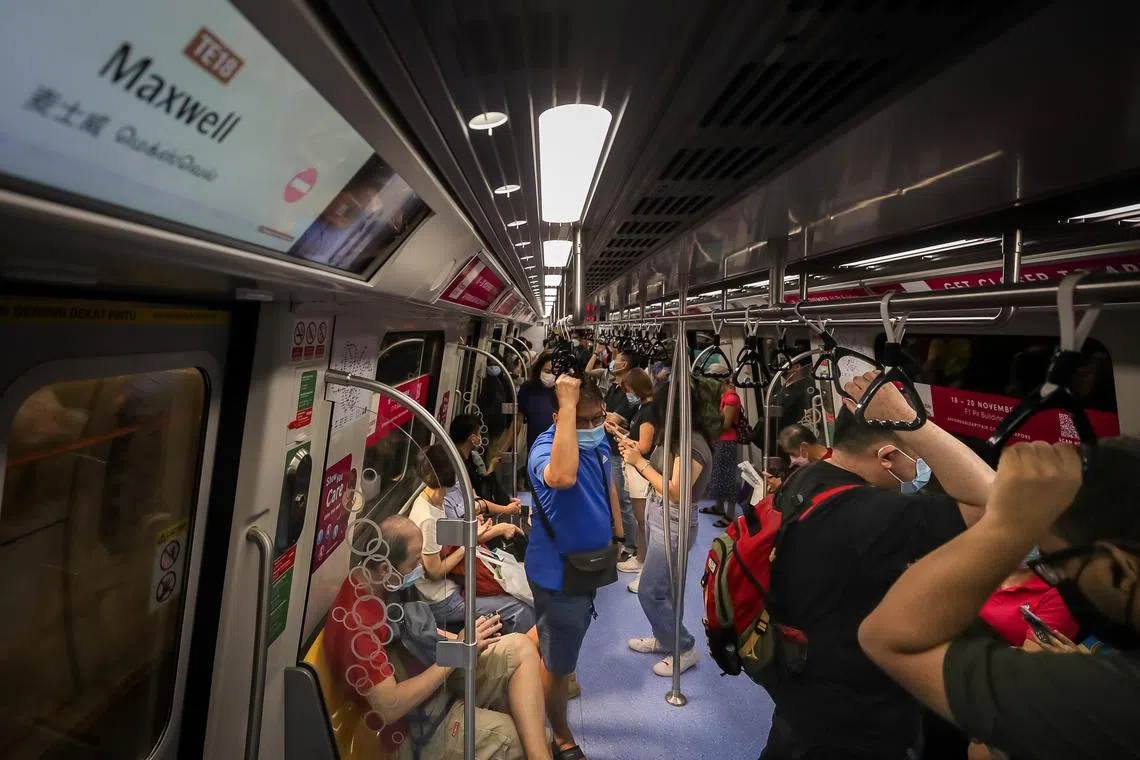Commuters hop onto MRT trains at 11 new TEL stations for free rides on Nov 11
Sign up now: Get ST's newsletters delivered to your inbox

Commuters at Orchard MRT station on the Thomson-East Coast Line on Friday.
ST PHOTO: GAVIN FOO
Follow topic:
SINGAPORE - For Mr Ang Chwee Kiat, 68, and his wife, 67, a trip to Maxwell Food Centre by public transport from their home in River Valley used to take up to 45 minutes.
But on Friday morning, the journey was shortened to about 25 minutes, thanks to the Thomson-East Coast Line (TEL). Their journey took them from Great World MRT station to Maxwell MRT station.
They were among the commuters who took advantage of free rides from 10am to 9pm on Friday on the third stage of the TEL,
The 11 stations, from Stevens through Outram Park and Orchard to Gardens by the Bay, will be closed on Saturday in preparation for their official opening for passenger service on Sunday.
Two other stations in the third stage – Mount Pleasant and Marina South – will begin operations only when housing developments around them are ready.
At 10.30am on Friday, commuters streamed into Orchard station, occupying most of the seats on the trains.
The stations on the line’s third stage were filled with commuters, many of whom were seniors, who took photos and videos in the stations and on the trains. They also took part in fringe activities and visited booths set up at the stations.
About 500,000 people turned up on Friday for the opening event, the Land Transport Authority said.
Besides giving easier access to places such as Upper Thomson and Gardens by the Bay, the new line provides an alternative route in case of train breakdowns, said Mr Ang.
“It is very important that we have more options to get around instead of being stuck at one place when trains break down,” said the retiree who used to work in the banking industry, and who had been caught in a breakdown before.
Transport Minister S. Iswaran, who was at the opening event at Orchard station, said the TEL is another step towards building a well-connected and resilient rail network as it connects with every MRT line.

Transport Minister S. Iswaran on a Thomson-East Coast Line MRT train from Orchard to Havelock station on Nov 11.
ST PHOTO: GAVIN FOO
Stevens station on the TEL connects to the Downtown Line, Orchard station to the North-South Line, Outram Park to the East-West and North-East lines and Marina Bay to the Circle and North-South lines.
The TEL’s first stage opened in January 2020
When fully opened, the TEL will be 43km long with 32 stations. It will serve about 500,000 commuters daily in the initial years, and about one million later.
Mr Iswaran noted that the planning, building and opening of an MRT line spans decades. The TEL’s history goes back 15 to 20 years, he said.
“TEL was announced in 2014 as a merger between two lines – the Thomson Line, which was announced in 2008, and the Eastern Region Line, which was conceptualised in the early 2000s,” he said.
The 11 new stations on the line make travelling across Singapore more convenient, said Ms Selena Wong, 41, adding that she looks forward to taking the train to places such as Gardens by the Bay.
The financial adviser, who usually commutes by car, said: “We used to cycle at Gardens by the Bay on the weekends, but it can be very difficult to find parking there.”
The mother of two, whose family lives in River Valley, added that she hopes her children, aged seven and nine, can enrol in schools near Stevens station in the future.

Commuters on a Thomson-East Coast Line MRT train arriving at Maxwell station on Nov 11.
ST PHOTO: GAVIN FOO
The TEL stations are designed to be more user-friendly, with signs that have larger text and exits that are numbered instead of labelled by letters of the alphabet.
Ms Eunice Ng, 65, who was at Maxwell station, said that numbered exits are easier for people, especially the elderly, to remember.
“Older folks may not be able to recognise the letters as their first language may not be English,” said the retiree, who used to work in the food and beverage industry.



